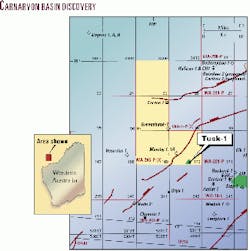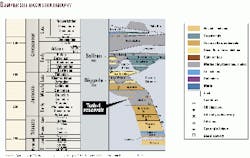A group led by a unit of Apache Corp., Houston, said analysis of core samples from the Tusk 1 oil discovery has validated a new play concept in the offshore Carnarvon basin of western Australia.
Tusk is on the WA-246-P Permit. The well was drilled in September, and the companies involved just completed a core analysis from Athol formation reservoirs. The results confirm earlier log data and indicate the oil-bearing, fine-grained sandstones have good reservoir characteristics with 21-29% porosities and fair to good permeability.
Three oil-bearing sandstones (6.6 m, 12 m, and 6 m) were intersected in Athol, and a separate 8.5 m oil column was intersected at the top of the underlying Triassic Mungaroo formation sands at a depth of 1,297 m.
Oil-water contact has been established at 1,307 m. Oil recovered during wireline sampling measured 17-18° gravity.
Apache has high hopes of commercializing the discovery and plans to drill an appraisal well in early 2001 that should indicate the lateral and downdip extent of the oil accumulation in the Athol formation and provide further data on the reservoir characteristics.
Based on data on hand so far, Apache postulates Tusk could contain 5-10 million bbl of recoverable oil. If Tusk 2 is successful, that could rise significantly.
Development would most likely consist of two or three subsea wells tied back to the Stag oil field production facilities 16 km to the east.
The Tusk result has upgraded the whole permit, where several other similar prospects, including Okapi about 2 km east of Tusk, have yet to be drilled.


